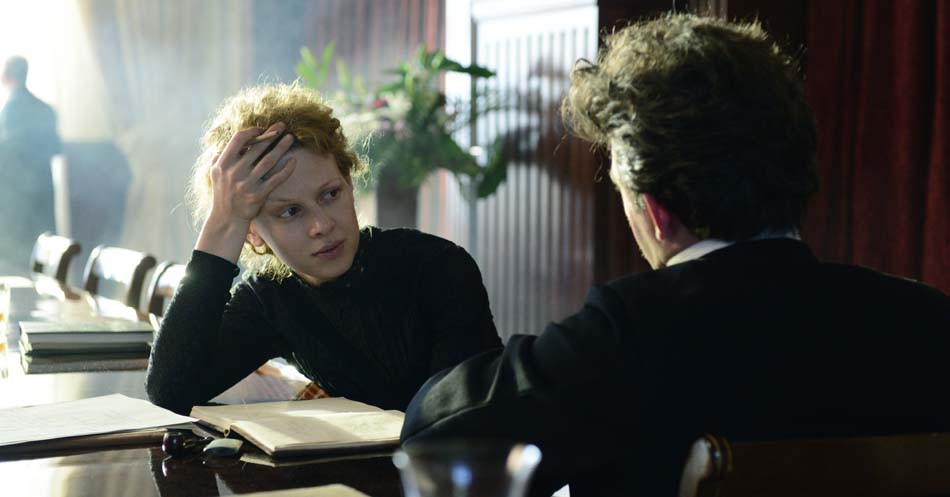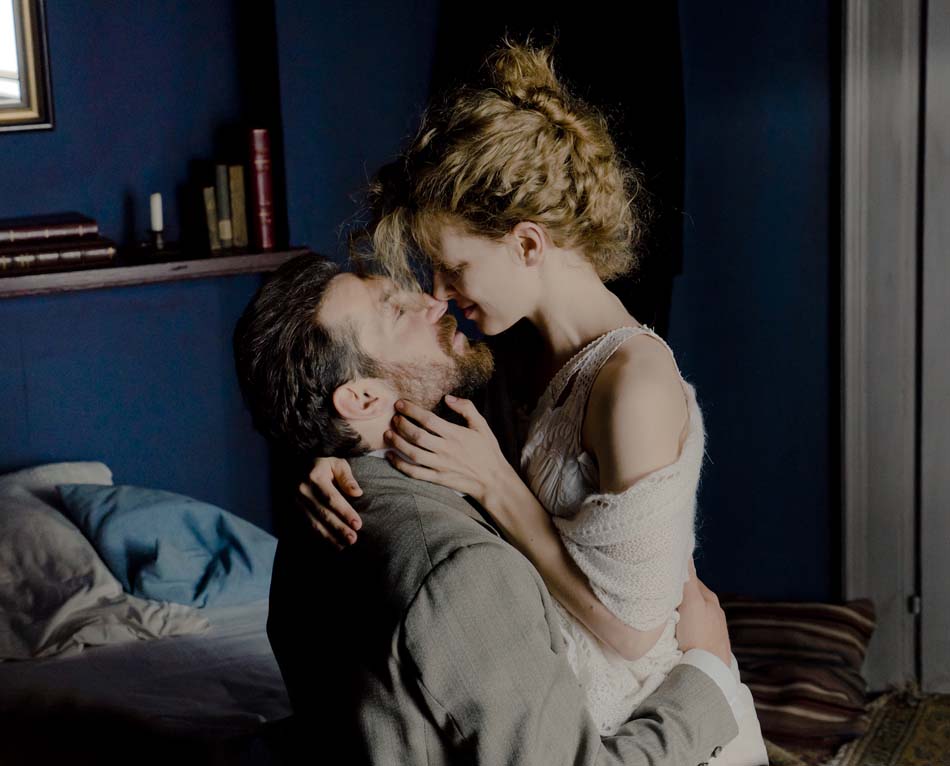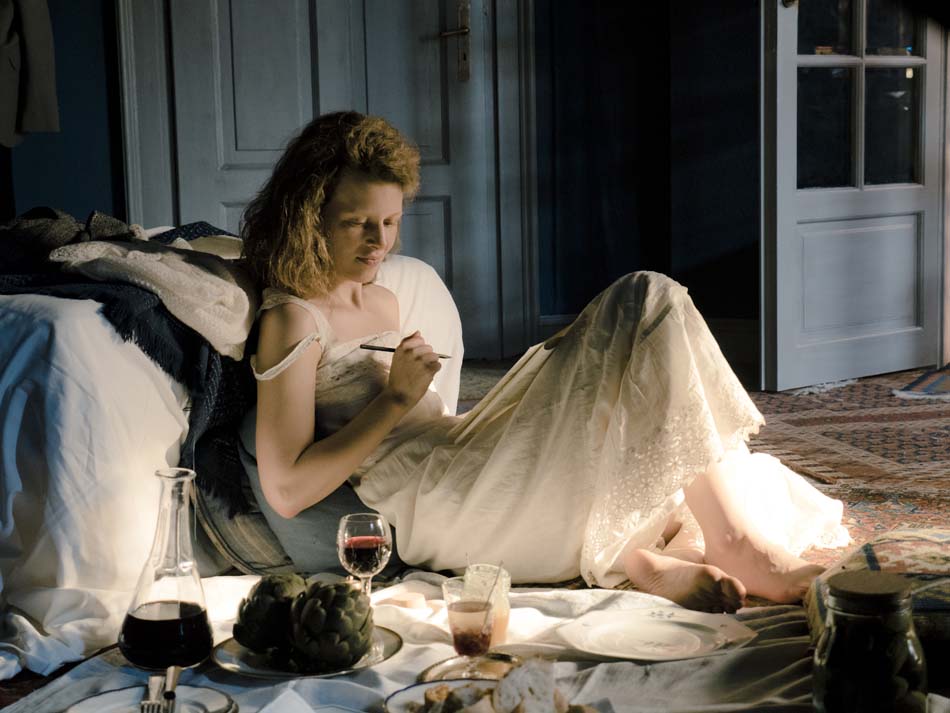The first woman to win a Nobel Prize; and not just one, but two, with the second making her the first person to ever win two Nobels in two different fields. (Linus Pauling is the only other.) The first female professor at the University of Paris. She headed the Radium Institute (now the Curie Institute). She developed the theory of radioactivity and coined the term. She discovered two elements now found on the Periodic Table – polonium and radium. During WWI she developed mobile x-ray units which then shaped the method of medical care in field hospitals by providing x-ray capability, and she became director of the Red Cross Radiology Service. A wife. A mother. A physicist and chemist. She is MARIE CURIE.

Under the direction of Marie Noëlle, in MARIE CURIE: THE COURAGE OF KNOWLEDGE, Polish actress Karolina Gruszka becomes the very essence of Marie Curie, both as a scientist and a woman. When people think of women’s rights and feminists, Marie Curie is one of the first faces that should come to mind. Not to take away from Mervyn Leroy’s 1943 “Madame Curie” starring Greer Garson, or Claude Pinoteau’s 1997 version, but for a cinematic look at MARIE CURIE, THIS is the film to see as it delves into the woman behind the science and how “that woman” is what allowed the curiosity for the science to blossom. Talk about an exquisite film! Visually stunning. Fascinating story and solidly engaging construct.

In MARIE CURIE: THE COURAGE OF KNOWLEDGE, directed by Marie Noëlle and co-written by Noëlle and Andrea Stoll, Curie’s story is approached through emotion, romance, and her love for her husband Pierre and their children, with strong focus on her feminist battles. We meet the woman behind the scientist which serves as a springboard for the professional aspects of Curie’s life, often commingled and co-dependent upon her emotional attachments. Curie’s femininity, something of which we have rarely heard or seen, takes center stage, giving us insight and understanding into her mind and drive. But it also serves as a wonderful counter-weight to the hard-charging, fiercely independent woman who fights for her rightful place and recognition in the scientific community and beyond. One shortcoming, however, is that the script focuses more on MARIE CURIE the woman and her feminist and romantic interests than with the actual science, research, and Curie’s contributions and discoveries during this time period which appear to take a backseat.
Also getting somewhat of a short shrift is Marie’s relationship with her children and the idea of encouraging science and math for young children, especially girls. While we see family interaction in the kitchen and play in the yard, and the love that both Marie and Pierre had for their two girls, the film glosses over the interest in and encouragement of science and math for the Curie daughters; so under-developed that the girls could have been removed from the film without disrupting the core story. While we do see eldest daughter Irene (who was the apple of her father’s eye) with Marie accepting Marie’s second Nobel, a stronger foundation of the mother-daughter relationship and science should have been developed, particularly given that Irene went on to follow in her mother’s footsteps, herself being awarded a Nobel in 1935 for discovering artificial radioactivity, and that Irene’s children also went on to become scientists in their own right.

Focusing on the time period between the two Nobel Prizes during her marriage and professional partnership with husband Pierre, and her affair with colleague Paul Langevin following Pierre’s death, Karolina Gruszka deftly navigates choppy emotional seas of triumph and tragedy, love and loss. We feel Curie’s frustration and anger when rebuffed by all as to her accomplishments, with many choosing to deny her abilities and credit work to the deceased Pierre. Gruszka taps into emotion as if a pressure cooker, building and building until she explodes; explodes in romantic, frenzied and languid afternoon delights with Pierre; in a wave of visceral carnal fury with Paul Langevin; or with charged words and defiance to the Fellows of the University of Paris and the Nobel committee. But Gruszka also brings a deliberate and methodical focus to Curie when engaged in her comfort zone of research and experiments. And the pure joy on the discovery of neon blue radium, lights up her face, literally and figuratively.
Matching Gruszka note-for-note is Arieh Worthalter as Paul Langevin. With an undeniable chemistry, the two make for believable academic partners and bedfellows. As Pierre Curie, Charles Berling takes a backseat to Gruszka, fading into dreams once Pierre dies at the hand of a horse-drawn carriage. The power of their romantic liaisons in the first act sets the stage for Marie’s unbridled appetite for sex, knowledge, and discovery.

Standout is Piotr Glowacki as a young Albert Einstein, a great admirer of Curie and her work.
As strong as Gruszka’s performance is, Noëlle’s visual design is ever moreso. Absolutely stunning. Through the visuals we feel the complexity of both Marie Curie’s mind and heart. Romanticized soft imagery mirrors the personal feminine side of Curie while dark wooded university halls or sterile laboratories serve as a counter, thus showing both sides of the coin and allowing her battle for equality to unfold with believability and authenticity.

Together with cinematographer Michal Englert, a visual tonal bandwidth is designed that calls on meticulous and calculated lensing that is so exacting in its framing and lighting it metaphorically speaks to what may be believed to be the exacting nature of Curie’s own mind. Montages and split-screen compositions and slo-motion create a harmonious flow in elegantly showing the passage of time and significant moments which lead to scientific breakthroughs. Camera movement is varied with everything from standard tripod, minimal tracking, Steadicam and even shaky handheld, the latter used judiciously as to reflect more unsettling moments.

Lighting is exemplary as the Curie home laboratory has one entire side of the building windowed with light streaming through daily. There is an openness about the work of Pierre and Marie, and thereafter Marie, which also extends into the yard where their children play and “experiment” with science and nature, always with abundant light. Similarly, the Curie home and notably the white trimmed kitchen, is filled with natural light. The metaphor of light, life, and the light of discovery is celebratory and omnipresent.
Interesting are intimate scenes between Marie and Paul Langevin. Hidden away in a secret apartment unknown to Paul’s wife, as the two lovers meet there is always a light and dark balance to the room, speaking directly to the clandestine affair, but the reflection and color always feel electrified. On the flip side, when battling the academics for her rightful place at the University or for accreditation for papers or discoveries, light typically comes from fewer and shorter windows placed within dark paneled rooms, allowing us to feel the choke hold these male dominated institutions are trying to inflict while the light always fall on Marie Curie. The lighting design tells its own story.

And then there’s color. The use of neon blue, the color of the radium salts isolated by Marie and Pierre, permeates the film with touches in the Curie home, Langevin’s apartment, serving as a tacit reminder of Marie Curie’s accomplishments. And white; bright clean white. Both give the film as a whole a glow, the glow of radium, radiating within each frame and off the screen. The vibrancy is exquisite.
Although feeling frenzied at times as if keeping time to Marie’s intellect and brain waves, Bruno Coulais’ score adds to the film’s overall aesthetic.
Directed by Marie Noëlle
Written by Marie Noëlle and Andrea Stoll
Cast: Karolina Gruszka, Arieh Worthalter, Charles Berling, Piotr Glowacki
French with English subtitles.
by debbie elias, 06/29/2017











